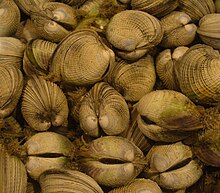

A bivalve shell is the enveloping exoskeleton or shell of a bivalve mollusc, composed of two hinged halves or valves. The two half-shells, called the "right valve" and "left valve", are joined by a ligament and usually articulate with one another using structures known as "teeth" which are situated along the hinge line. In many bivalve shells, the two valves are symmetrical along the hinge line — when truly symmetrical, such an animal is said to be equivalved; if the valves vary from each other in size or shape, inequivalved. If symmetrical front-to-back, the valves are said to be equilateral, and are otherwise considered inequilateral.
The bivalve shell not only serves as protection from predators and physical damage, but also for adductor muscle attachment, which can allow the mollusc to "swim" short distances by flapping the valves. The shell is secreted by a soft part of the molluscan body known as the mantle and has several layers, typically made of calcium carbonate precipitated out into an organic matrix.
Bivalves are very common in essentially all aquatic locales, including saltwater, brackish water and fresh water. The shells of dead bivalves commonly wash up on beaches (often as separate valves) and along the edges of lakes, rivers and streams. They are collected by professional and amateur conchologists and are sometimes harvested for commercial sale in the international shell trade or for use in glue, chalk, or varnish, occasionally to the detriment of the local ecology.